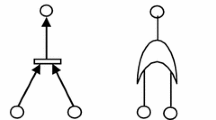Abstract
This paper presented a methodology, named as confidence interval based lambda-tau, for analyzing the behavior of complex repairable industrial systems by utilizing vague, uncertain and imprecise data. In this, uncertainties in the data related to each component of the system are estimated with the help of fuzzy and statistical methodology. Triangular fuzzy numbers are used for this purpose as it allows expert opinions, operating conditions, uncertainty and imprecision in reliability information. Various reliability parameters are addressed for analyzing the behavior of the system and their correspondingly obtained results of the proposed approach are compared with the existing fuzzy lambda-tau technique results. The sensitivity as well as performance analysis has also been performed to explore the effect of failure/repair rates of the components on system availability. The approach has been illustrated with an example of synthesis unit of a urea fertilizer plant situated in Northern part of India. The obtained results may be helpful for the plant personnel for analyzing the systems’ behavior and to improve their performance by adopting suitable maintenance strategies.





Similar content being viewed by others
References
Ebeling C (2001) An introduction to reliability and maintainability engineering. Tata McGraw-Hill Company Ltd., New York
Garg H, Rani M, Sharma SP (2013) Predicting uncertain behavior of press unit in a paper industry using artificial bee colony and fuzzy lambda-tau methodology. Appl Soft Comput 13(4):1869–1881
Zadeh LA (1965) Fuzzy sets. Inf Control 8:338–353
Cai KY (1996) System failure engineering and fuzzy methodology: an introductory overview. Fuzzy Sets Syst 83:113–133
Cai KY, Wen CY, Zhang ML (1991) Fuzzy variables as a basis for a theory of fuzzy reliability in the possibility context. Fuzzy Sets Syst 42:145–172
Karwowski W, Mittal A (1986) Applications of fuzzy set theory in human factors. Elsevier, Amsterdam
Chen SM (1994) Fuzzy system reliability analysis using fuzzy number arithmetic operations. Fuzzy Sets Syst 64(1):31–38
Chen SM (1996) New method for fuzzy system reliability analysis. Cyber Syst Int J 27:385–401
Cheng CH, Mon DL (1993) Fuzzy system reliability analysis by interval of confidence. Fuzzy Sets Syst 56(1):29–35
Mon DL, Cheng CH (1994) Fuzzy system reliability analysis for components with different membership functions. Fuzzy Sets Syst 64(2):145–157
Singer D (1990) A fuzzy set approach to fault tree and reliability analysis. Fuzzy Sets Syst 34(2):145–155
Yao JS, Su JS, Shih TS (2008) Fuzzy system reliability analysis using triangular fuzzy numbers based on statistical data. J Inf Sci Eng 24:1521–1535
Jamkhaneh EB, Nozari A (2012) Fuzzy system reliability analysis based on confidence interval. Adv Mat Res 433–440:4908–4914
Jamkhaneh EB, Nozari A, Ghara AN (2011) Analyzing fuzzy system reliability using confidence interval. World Appl Sci J 13(10):2191–2197
Das K (2008) A comparative study of exponential distribution vs Weibull distribution in machine reliability analysis in a CMS design. Comput Indus Eng 54:12–33
Garg H (2013) Performance analysis of complex repairable industrial systems using PSO and fuzzy confidence interval based lambda-tau methodology. ISA Trans 52(2):171–183
Garg H, Sharma SP (2012) Stochastic behavior analysis of industrial systems utilizing uncertain data. ISA Trans 51(6):752–762
Knezevic J, Odoom ER (2001) Reliability modeling of repairable systems using Petri nets and fuzzy lambda-tau methodology. Reliab Eng Syst Saf 73(1):1–17
Sharma SP, Garg H (2011) Behavioral analysis of a urea decomposition system in a fertilizer plant. Int J Ind Syst Eng 8(3):271–297
Bai X, Asgarpoor S (2004) Fuzzy based approaches to substation reliability evaluation. Electr Power Syst Res 69:197–204
Pedrycz W (1994) Why triangular membership functions? Fuzzy Sets Syst 64(1):21–30
Garg H (2013) Reliability analysis of repairable systems using Petri nets and Vague lambda-tau methodology. ISA Trans 52(1):6–18
Ross TJ (2004) Fuzzy logic with engineering applications, 2nd edn. Wiley, New York
Garg H, Sharma SP (2012) Behavior analysis of synthesis unit in fertilizer plant. Int J Qual Reliab Manag 29(2):217–232
Author information
Authors and Affiliations
Corresponding author
Rights and permissions
About this article
Cite this article
Garg, H. Analyzing the Behavior of an Industrial System Using Fuzzy Confidence Interval Based Methodology. Natl. Acad. Sci. Lett. 37, 359–370 (2014). https://doi.org/10.1007/s40009-014-0239-2
Received:
Revised:
Accepted:
Published:
Issue Date:
DOI: https://doi.org/10.1007/s40009-014-0239-2




